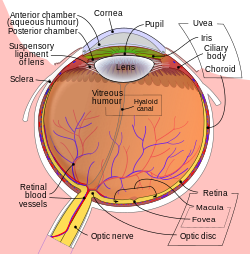| Pupil | |
|---|---|
 The pupil is the central opening of the iris on the inside of the eye, which normally appears black. The grey/blue or brown area surrounding the pupil is the iris. The white outer area of the eye is the sclera. The central outermost transparent colorless part of the eye (through which we can see the iris and pupil) is the cornea. | |
 Cross-section of the human eye, showing the position of the pupil. | |
| Details | |
| Part of | Eye |
| System | Visual system |
| Identifiers | |
| Latin | pupilla. (plural: pupillae) |
| MeSH | D011680 |
| TA98 | A15.2.03.028 |
| TA2 | 6754 |
| FMA | 58252 |
| Anatomical terminology | |
The pupil is a hole located in the center of the iris of the eye that allows light to strike the retina.[1] It appears black because light rays entering the pupil are either absorbed by the tissues inside the eye directly, or absorbed after diffuse reflections within the eye that mostly miss exiting the narrow pupil.[citation needed] The size of the pupil is controlled by the iris, and varies depending on many factors, the most significant being the amount of light in the environment. The term "pupil" was coined by Gerard of Cremona.[2]
In humans, the pupil is circular, but its shape varies between species; some cats, reptiles, and foxes have vertical slit pupils, goats and sheep have horizontally oriented pupils, and some catfish have annular types.[3] In optical terms, the anatomical pupil is the eye's aperture and the iris is the aperture stop. The image of the pupil as seen from outside the eye is the entrance pupil, which does not exactly correspond to the location and size of the physical pupil because it is magnified by the cornea. On the inner edge lies a prominent structure, the collarette, marking the junction of the embryonic pupillary membrane covering the embryonic pupil.
- ^ Cassin, B. and Solomon, S. (1990) Dictionary of Eye Terminology. Gainesville, Florida: Triad Publishing Company.
- ^ Arráez-Aybar, Luis-A (2015). "Toledo School of Translators and their influence on anatomical terminology". Annals of Anatomy - Anatomischer Anzeiger. 198: 21–33. doi:10.1016/j.aanat.2014.12.003. PMID 25667112.
- ^ Malmström T, Kröger RH (January 2006). "Pupil shapes and lens optics in the eyes of terrestrial vertebrates". J. Exp. Biol. 209 (Pt 1): 18–25. doi:10.1242/jeb.01959. PMID 16354774.